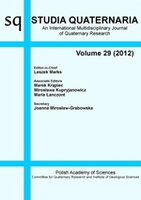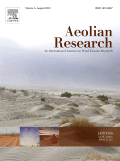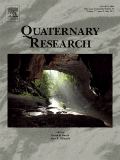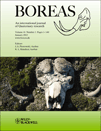
Studia Quaternaria
Scope & Guideline
Fostering global discourse in Earth-Surface Processes.
Introduction
Aims and Scopes
- Paleoenvironmental Reconstructions:
The journal emphasizes the reconstruction of past environments using various methodologies, including sediment analysis, tree-ring studies, and paleoecological assessments. - Geoarchaeology:
Research often explores the intersection of geology and archaeology, analyzing how geological processes influence human activities and vice versa, particularly in historical contexts. - Climate Change Impact Studies:
A significant focus is placed on understanding the effects of climate change on ecosystems, sediment transport, and geomorphological changes over the Quaternary period. - Sedimentology and Stratigraphy:
The journal publishes studies related to sediment composition, stratigraphic analysis, and the interpretation of geological records to understand the Earth's history. - Ecological and Environmental Assessments:
Research includes assessments of biotic communities, pollution impacts, and environmental changes, highlighting the ecological implications of geological processes.
Trending and Emerging
- Interdisciplinary Approaches to Climate Change:
There is a growing trend in combining geological and ecological methods to assess the impacts of climate change, indicating a need for comprehensive studies that address both past and present environmental changes. - Technological Innovations in Geoscience:
The use of advanced technologies such as ground-penetrating radar and multivariate statistical methods is increasingly common, showcasing a trend towards more precise and detailed analyses in geological and archaeological research. - Focus on Local and Regional Ecologies:
Recent studies are showing more attention to local ecological impacts and the significance of regional biota, reflecting a broader interest in conservation and environmental management within specific geographic contexts.
Declining or Waning
- Anthropogenic Pollution Studies:
Although still relevant, the frequency of publications specifically dedicated to anthropogenic pollution and its effects on the environment has decreased, possibly due to a shift towards broader ecological assessments. - Traditional Geological Mapping:
Research focused solely on traditional geological mapping techniques appears to be waning, as more interdisciplinary approaches that integrate geomorphology and environmental science gain traction. - Nematode and Microbial Community Studies:
While important for understanding ecological dynamics, studies specifically examining nematode and microbial communities in isolation are less common, indicating a move towards more holistic ecological studies.
Similar Journals

Aeolian Research
Pioneering Studies in Earth-Surface DynamicsAeolian Research, published by ELSEVIER SCI LTD, is a leading academic journal in the fields of Earth-Surface Processes and Geology, holding a prestigious Q1 category ranking in both disciplines as of 2023. With an ISSN of 1875-9637 and an E-ISSN of 2212-1684, this journal is pivotal for researchers and scholars interested in the intricate dynamics of aeolian processes and their implications for geology and environmental science. Covering a span of research from 2009 to 2024, it regularly disseminates high-impact studies that explore the interactions between wind-driven processes and sediment transport, erosion, and landscape evolution. With a Scopus ranking of #34 and #20 in their respective categories, Aeolian Research serves as an essential resource for advancing knowledge in Earth and Planetary Sciences. While currently not an open-access journal, it delivers compelling insights that are relevant to contemporary challenges in geology and environmental management.

QUATERNARY RESEARCH
Illuminating Interdisciplinary Insights into Earth's Recent Changes.QUATERNARY RESEARCH, published by Cambridge University Press, is a leading academic journal that focuses on the study of the Quaternary Period, the most recent geological time period. With a strong emphasis on interdisciplinary research, the journal has significantly contributed to our understanding of Earth's dynamic systems and processes, making it an essential resource for researchers and professionals in the fields of Earth and Planetary Sciences, Earth-Surface Processes, and the Arts and Humanities. It is recognized for its high-impact contributions, reflected in its impressive Q1 rankings across multiple categories, including its position as 69th out of 552 in Arts and Humanities and 49th out of 195 in General Earth and Planetary Sciences, showcasing its influence and relevance in the academic community. While QUATERNARY RESEARCH does not provide open access options, it remains a crucial platform for disseminating valuable research findings and fostering scholarly dialogue. The journal's coverage spans from 1970 to 2024, serving as a comprehensive archive of key developments in the field.

E&G Quaternary Science Journal
Illuminating the Quaternary Period’s MysteriesE&G Quaternary Science Journal, published by COPERNICUS GESELLSCHAFT MBH in Germany, stands as a prominent open-access platform dedicated to disseminating high-quality research in the fields of archaeology, geology, paleontology, and stratigraphy since its inception in 1979. With its ISSN 0424-7116 and E-ISSN 2199-9090, the journal has achieved remarkable recognition, indicated by its Q1 quartile ranking in archaeology across both arts and humanities sections, and its strong placements within the social sciences and Earth sciences categories. The journal provides crucial insights into the Quaternary period, contributing to our understanding of climate change, human evolution, and geological processes, making it invaluable for researchers, professionals, and students engaged in these collaborating disciplines. As an open-access journal since 2008, it ensures that cutting-edge research is readily available to a global audience, promoting knowledge exchange and facilitating advancements within the scientific community. The continuous commitment to excellence and its strategic focus on high-impact research positions E&G Quaternary Science Journal as a cornerstone publication in quaternary science.

JOURNAL OF PALEOLIMNOLOGY
Illuminating the Interplay of Environment and Aquatic LifeJOURNAL OF PALEOLIMNOLOGY, published by Springer, stands as a pivotal resource in the field of paleolimnology, bridging the disciplines of aquatic sciences and earth-surface processes. With an impact factor that showcases its scholarly influence and ranking it in the Q2 category for both Aquatic Science and Earth-Surface Processes, this journal has established a reputation for advancing our understanding of past aquatic environments through rigorous studies of sedimentary records. Since its inception in 1988, it has become a vital platform for researchers to disseminate their findings on climate change, biodiversity, and ecological shifts, revealing insights crucial for contemporary environmental science. Despite the lack of open-access options, the journal provides numerous subscription-based resources, ensuring that vital research is accessible to a wide audience. Located in the Netherlands, the journal continues to attract contributions from a global network of scholars aiming to explore the interplay between environmental change and aquatic systems.

Gondwana Research
Advancing the Frontiers of Geological DiscoveryGondwana Research is a premier academic journal published by Elsevier, specializing in the field of geology, with a robust focus on the geological history and processes of the Gondwana supercontinent. With an impressive impact factor and ranking as Q1 in the 2023 Geology category, it stands as a leading platform for disseminating high-quality research. The journal features articles that advance the understanding of Earth and planetary sciences, making significant contributions to geological education and research. Researchers will find its curated content particularly valuable, as it encompasses a wide array of topics including stratigraphy, paleontology, and tectonics, all relevant to both contemporary and historical geological inquiries. Given its substantial reach and esteemed standing—ranked 5th out of 321 in its field—Gondwana Research plays a crucial role in fostering scientific exchange among global experts. Located in the United States with publication continuity from 1997 to 2024, this journal consistently attracts submissions from leading scientists, ensuring that its readership is kept at the forefront of geological discovery and innovation.

Cuaternario y Geomorfologia
Bridging Disciplines for a Deeper Earth UnderstandingCuaternario y Geomorfologia is a distinguished journal published by the Spanish Quaternary Research Association, focusing on the interdisciplinary study of Quaternary research, geomorphology, and related fields. With its ISSN 0214-1744 and a publication history spanning from 2012 to 2024, the journal serves as a critical platform for researchers and practitioners in geography, geology, and paleontology. Although its current Scopus rankings place it in the lower quartiles across various categories, being Q4 in Earth-Surface Processes, Geography, Planning and Development, Geology, and Paleontology, Cuaternario y Geomorfologia continues to push boundaries within its sphere, aiming to foster a deeper understanding of Earth sciences. Situated in Madrid, Spain, the journal's commitment to sharing groundbreaking research without access barriers enhances its value for academics, offering insights that drive forward the fields of Quaternary studies and beyond. Researchers, professionals, and students alike will find a rich repository of knowledge within its pages, making it an essential resource for current and aspiring experts in the discipline.

BOREAS
Fostering Groundbreaking Discoveries Since 1972BOREAS is a prestigious academic journal published by WILEY, dedicated to advancing knowledge across the fields of Archaeology, Ecology, Evolution, Behavior, Systematics, and Geology. With a commendable track record since its inception in 1972, BOREAS has consistently contributed to the scholarly landscape, currently holding a distinguished position in Q1 across multiple categories, including a ranking of #8 in Archaeology and a solid percentile rank in Ecology and Geology. This high-impact journal fosters the dissemination of groundbreaking research, further establishing itself as a vital resource for researchers, professionals, and students alike. While access options are limited to subscription-based, the quality and significance of research published in BOREAS make it an essential addition to any academic library, ensuring that studies conducted in these pivotal fields reach a global audience. With a commitment to excellence and innovation, BOREAS continues to drive forward the frontiers of knowledge and understanding in Earth and planetary sciences.

Journal of Asian Earth Sciences-X
Bridging Regional Insights with Global PerspectivesJournal of Asian Earth Sciences-X, a distinguished publication by ELSEVIER, is at the forefront of Earth and planetary sciences, particularly focusing on the dynamic fields of geology and earth-surface processes. As an Open Access journal since 2019, it provides unparalleled access to high-quality research, fostering global collaboration and dissemination of knowledge. With an impressive impact factor and ranking in the Q2 category for both Earth-Surface Processes and Geology, it serves as a crucial platform for researchers, professionals, and students alike to share their findings and insights. Situated in the United Kingdom, the journal thrives on contributions that enhance our understanding of Asian geosciences within a broader global context, aiming to tackle major challenges such as climate change and natural resource management. By bridging regional studies with global perspectives, the Journal of Asian Earth Sciences-X is not only a vital resource for academia but also supports sustainable development initiatives across the region.

JOURNAL OF SEDIMENTARY RESEARCH
Connecting Scholars through Sedimentary DiscoveriesThe JOURNAL OF SEDIMENTARY RESEARCH, published by SEPM-SOCIETY FOR SEDIMENTARY GEOLOGY, stands as a pivotal peer-reviewed journal in the field of sedimentary geology. With an ISSN of 1527-1404 and an E-ISSN of 1938-3681, this esteemed journal features a broad scope, delving into the intricacies of sedimentary processes, lithology, and stratigraphy since its inception in 1931. Enjoying a distinguished reputation, it has achieved a Q1 category ranking in Geology for 2023 and ranks 87 out of 321 in Earth and Planetary Sciences, placing it in the 73rd percentile among its peers in Scopus. With continued access options available, it facilitates the dissemination and discussion of cutting-edge research that shapes the understanding of sedimentary phenomena. Researchers, professionals, and students alike benefit from this critical platform that fosters academic engagement and drives progress within the field.

Journal of Sedimentary Environments
Connecting Researchers to Shape the Future of Sedimentary Studies.Journal of Sedimentary Environments is a leading open-access publication dedicated to advancing the study of sedimentary processes and environments. Published by SPRINGER HEIDELBERG, this journal embraces a wide array of topics including sedimentology, paleoenvironments, and the interactions between sediments and ecosystems. Since its transition to open access in 2016, it has prioritized making high-quality research widely available, fostering collaboration and innovation among researchers, professionals, and students in the field. With a commitment to excellence, the journal aims to publish groundbreaking studies that enhance our understanding of sedimentary environments, making it an essential resource for anyone interested in the dynamics of Earth’s sedimentary systems. Located in Heidelberg, Germany, this journal is poised to play a vital role in shaping current and future research discussions worldwide.